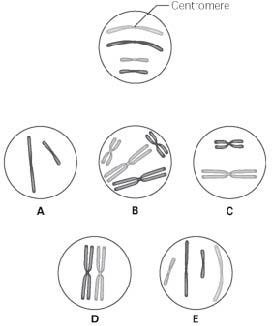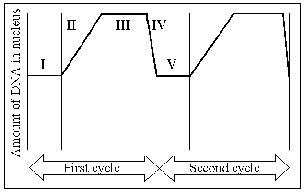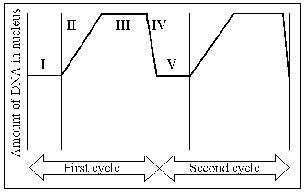Instructions for Side by Side Printing
- Print the notecards
- Fold each page in half along the solid vertical line
- Cut out the notecards by cutting along each horizontal dotted line
- Optional: Glue, tape or staple the ends of each notecard together
biology chapter 9
front 1 If a eukaryotic cell is in the G1 phase of the cell cycle, which statement about the cell’s chromosomes must be correct? | back 1 Each chromosome is made of a complex of DNA and associated proteins |
front 2 Which statement provides the best description of the interphase portion of the cell cycle? | back 2 During interphase, a cell is metabolically active. |
front 3 Why is it difficult to observe individual chromosomes with a light microscope during interphase? | back 3 They have uncoiled to form long, thin strands |
front 4 Which of the following is true of benign tumors, but not malignant tumors? | back 4 They remain confined to their original site |
front 5 A human bone marrow cell, in prophase of mitosis, contains 46 chromosomes. How many chromatids does it contain? | back 5 92 |
front 6 Which of the following is true of kinetochores? | back 6 They are sites at which microtubules attach to chromosomes. |
front 7 Cells will usually divide if they receive the proper signal at a checkpoint in which phase of the cell cycle? | back 7 G1 |
front 8 Through a microscope, you can see a cell plate beginning to develop across the middle of a cell and nuclei forming on either side of the cell plate. This cell is most likely | back 8 a plant cell in the process of cytokinesis. |
front 9 Which of the following does not occur during mitosis | back 9 replication of the DNA |
front 10  The unlettered circle at the top of the figure shows a diploid nucleus with four chromosomes that have not yet replicated. There are two pairs of homologous chromosomes, one long and the other short. One haploid set is black, and the other is gray. The circles labeled AE show various combinations of these chromosomes. What is the correct chromosomal condition for one daughter nucleus at telophase of mitosis? | back 10 E. |
front 11  In the figure, mitosis is represented by which numbered part(s) of the cycle? | back 11 IV |
front 12  Which number represents DNA synthesis? | back 12 II |
front 13 Which of the following correctly matches a phase of the cell cycle with its description? | back 13 G1 Follows cell division |
front 14 In some organisms, such as certain fungi and algae, cells undergo the cell cycle repeatedly without subsequently undergoing cytokinesis. What would result from this? | back 14 large cells containing many nuclei |
front 15 Which of the following is found in binary fission but not in mitosis? | back 15 Duplicated chromosomes attach to the plasma membrane. |